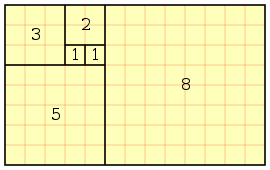Fibonacci numbers: 1,1,2,3,5,8,13,21,34,55....
Every following number in the Fibonacci sequence is an addition of the two previous numbers.
Take all of these numbers, square them, and lay their squares out one to the right of the other.
From the innermost corner, express the radius of every square that you have laid out in the sequence:

Then:

Here's my question:
Is there a common ration between (Two numbers in the sequence), back to back, compared to (every other number ADDED previously in the sequence)?
You can definitely see similar shapes reoccur once you can understand what i;m trying to explain... i'm not the best at explaining things. I dont know where to start, or what to look for.. specifically. i just came out of pre-calc and I'm a junior. i would like someone with some more in-depth knowledge to help me with this one.
None.

Relatively ancient and inactive


Just back to back ratio of a number to the previous one? In the fibonacci sequence? I once for a project wrote a small script that figured this out to whatever decimal place you needed.
EDIT: My PHP doesn't seem to be working, so I can't give you the exact, but the ratio in general was something like 2.5. I'll try to get PHP to work. The squared version would just be that ~2.5 squared.
Actually, it seems you're asking the ratio of (F
x + F
x+1)/(F
x-1 + F
x-2 + .... + F
0). Is that what you want?
None.
ahh! perfect. thats exactly what im looking for. something to that respect. The two shapes (two numbers together in a sequence) compared to every other number previously. It looks like you summed that up very nicely with that expression.
None.
I can find the pattern, but ratio...I believe it just keeps growing. 1:1, 1:2, 2:3, 3:5, 5:8 If that is what you're looking for...
None.

Relatively ancient and inactive


It keeps growing toward a certain constant. I actually get the feeling that it's e, but I'm not sure. (F
x / F
x-1)
Let's see... Can this wait for tomorrow, then? I'll need to install some other medium with which to test it out.
The one you're looking for looks like 4.3 or something.
Post has been edited 1 time(s), last time on Feb 12 2009, 3:53 am by Centreri.
None.
By all means.... im working at it on my calculator with the dimensions that you supplied.
None.
Fibonacci numbers: 1,1,2,3,5,8,13,21,34,55....
Every following number in the Fibonacci sequence is an addition of the two previous numbers.
Take all of these numbers, square them, and lay their squares out one to the right of the other.
From the innermost corner, express the radius of every square that you have laid out in the sequence:

Then:

Here's my question:
Is there a common ration between (Two numbers in the sequence), back to back, compared to (every other number ADDED previously in the sequence)?
You can definitely see similar shapes reoccur once you can understand what i;m trying to explain... i'm not the best at explaining things. I dont know where to start, or what to look for.. specifically. i just came out of pre-calc and I'm a junior. i would like someone with some more in-depth knowledge to help me with this one.
1:
1:1
2:2
3:4
5:7
8:12
13:20
21:33
34:54
55:88
?
It keeps growing toward a certain constant. I actually get the feeling that it's e, but I'm not sure. (Fx / Fx-1)
Let's see... Can this wait for tomorrow, then? I'll need to install some other medium with which to test it out.
The one you're looking for looks like 4.3 or something.
It tends towards φ, if he meant what I posted above this.
So...
For... F
n = F
n-1 + F
n-2; F
1 = 1, F
2 = 1

(Made a nice image for you, 'cause it would've been really hard to interpret if I'd typed it.)
Post has been edited 2 time(s), last time on Feb 12 2009, 5:44 am by Syphon.
None.












